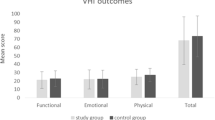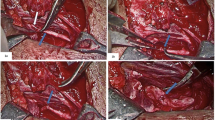Abstract
Surgery of patient with bilateral vocal fold paralysis must often balance the effects of surgical treatment on both the voice and airway. In both the acute and the chronic management of the patient with bilateral vocal fold paralysis, the decision must incorporate the prognosis of the injury and the potential for recovery, the severity of the injury, and the functional needs of the patient. Better airway may occasionally need to be sacrificed for better voice and vice versa. Impaired cough and impaired swallow may also need to be considered where permanent laryngeal dilation is being done. As part of the workup, advanced functional studies of respiration and voice may incorporate fiber-optic and rigid laryngoscopy with stroboscopy, pulmonary function testing with flow loop studies, laryngeal electromyography, and CT radiographic imaging. In the management of patients with acute vocal fold paralysis, temporary tracheostomy, arytenoid lateralization suture, and Botox injection into the adductors may have a role in improving airway, while injection laryngoplasty has a role in improving voice. In consideration of the permanent procedures to open the airway in patient with bilateral vocal fold paralysis, static procedures such as open and endoscopic arytenoidectomy, open arytenoid lateralization procedures, and transverse cordotomy with myectomy may be considered. Lipo injection, bilateral medialization laryngoplasty, and medialization laryngoplasty with or without arytenoid adduction have a role in patients with voice disturbance with glottal incompetence. Nonselective and selective reinnervation can be performed in patients to achieve dynamic rehabilitation and restore function.
Access this chapter
Tax calculation will be finalised at checkout
Purchases are for personal use only
Similar content being viewed by others
References
Benninger MS, Crumley RL, Ford CN, et al. Evaluation and treatment of the unilateral paralyzed vocal fold. Otolaryngol Head Neck Surg. 1994;111:497–508.
Benninger MS, Gillen JB, Altman JS. Changing etiology of vocal fold immobility. Laryngoscope. 1998;108:1346–50.
Francis DO, Pearce EC, Ni S, Garrett CG, Penson DF. Epidemiology of vocal fold paralyses after total thyroidectomy for well-differentiated thyroid cancer in a Medicare population. Otolaryngol Head Neck Surg. 2014;150:548–57.
Morpeth JF, Williams MF. Vocal fold paralysis after anterior cervical diskectomy and fusion. Laryngoscope. 2000;110:43–6.
Ko HC, Lee LA, Li HY, Fang TJ. Etiologic features in patients with unilateral vocal fold paralysis in Taiwan. Chang Gung Med J. 2009;32:290–6.
Al-Khtoum N, Shawakfeh N, Al-Safadi E, Al-Momani O, Hamasha K. Acquired unilateral vocal fold paralysis: retrospective analysis of a single institutional experience. N Am J Med Sci. 2013;5:699–702.
Hillel AD, Benninger M, Blitzer A, et al. Evaluation and management of bilateral vocal cord immobility. Otolaryngol Head Neck Surg. 1999;121:760–5.
Li Y, Garrett G, Zealear D. Current treatment options for bilateral vocal fold paralysis: a state-of-the-art review. Clin Exp Otorhinolaryngol. 2017;10:203–12.
Su WF, Liu SC, Tang WS, Yang MC, Lin YY, Huang TT. Suture lateralization in patients with bilateral vocal fold paralysis. J Voice. 2014;28:644–51.
Hong YT, Park MJ, Shin YJ, Minh PHN, Hong KH. The phonetic characteristics in patients of bilateral vocal fold paralysis without tracheotomy. Clin Exp Otorhinolaryngol. 2017;10:272–7.
Nawka T, Sittel C, Gugatschka M, et al. Permanent transoral surgery of bilateral vocal fold paralysis: a prospective multi-center trial. Laryngoscope. 2015;125:1401–8.
Siu J, Tam S, Fung K. A comparison of outcomes in interventions for unilateral vocal fold paralysis: a systematic review. Laryngoscope. 2016;126(7):1616–24.
Mueller AH, Hagen R, Pototschnig C, et al. Laryngeal pacing for bilateral vocal fold paralysis: voice and respiratory aspects. Laryngoscope. 2017;127:1838–44.
Naunheim MR, Song PC, Franco RA, Alkire BC, Shrime MG. Surgical management of bilateral vocal fold paralysis: a cost-effectiveness comparison of two treatments. Laryngoscope. 2017;127:691–7.
Aynehchi BB, McCoul ED, Sundaram K. Systematic review of laryngeal reinnervation techniques. Otolaryngol Head Neck Surg. 2010;143:749–59.
Yilmaz T, Altuntas OM, Suslu N, et al. Total and partial laser arytenoidectomy for bilateral vocal fold paralysis. BioMed Res Int. 2016;2016:3601612.
Marina MB, Marie JP, Birchall MA. Laryngeal reinnervation for bilateral vocal fold paralysis. Curr Opin Otolaryngol Head Neck Surg. 2011;19:434–8.
Lewis S, Woo P. Botulinum toxin in management of synkinesis in patients with unilateral and bilateral vocal fold paralysis. Laryngoscope. 2018;128:447–50.
Crumley RL. Laryngeal synkinesis revisited. Ann Otol Rhinol Laryngol. 2000;109:365–71.
Li Y, Huang S, Zealear D. An implantable system for in vivo chronic electromyographic study in the larynx. Muscle Nerve. 2017;55:706–14.
Woodman DG. Rehabilitation of the larynx in cases of bilateral abductor paralysis: open approach to arytenoidectomy, with report of the past four years’ experience. Arch Otolaryngol. 1949;50:91–5.
Woodson G. Arytenoid abduction: indications and limitations. Ann Otol Rhinol Laryngol. 2010;119:742–8.
Thornell WC. Intralaryngeal approach for arytenoidectomy in bilateral abductor paralysis of the vocal cords. Arch Otolaryngol. 1948;47:505–8.
Lichtenberger G. Comparison of endoscopic glottis-dilating operations. Eur Arch Otorhinolaryngol. 2003;260:57–61.
Dennis DP, Kashima H. Carbon dioxide laser posterior cordectomy for treatment of bilateral vocal cord paralysis. Ann Otol Rhinol Laryngol. 1989;98:930–4.
Andrade Filho PA, Rosen CA. Bilateral vocal fold paralysis: an unusual treatment with botulinum toxin. J Voice. 2004;18:254–5.
Benninger MS, Hanick A, Hicks DM. Cricothyroid muscle botulinum toxin injection to improve airway for bilateral recurrent laryngeal nerve paralysis, a case series. J Voice. 2016;30:96–9.
Zealear DL, Swelstad MR, Sant’Anna GD, et al. Determination of the optimal conditions for laryngeal pacing with the Itrel II implantable stimulator. Otolaryngol Head Neck Surg. 2001;125:183–92.
Li Y, Pearce EC, Mainthia R, et al. Comparison of ventilation and voice outcomes between unilateral laryngeal pacing and unilateral cordotomy for the treatment of bilateral vocal fold paralysis. ORL J Otorhinolaryngol Relat Spec. 2013;75:68–73.
Tucker HM. Long-term results of nerve-muscle pedicle reinnervation for laryngeal paralysis. Ann Otol Rhinol Laryngol. 1989;98:674–6.
Li M, Chen S, Zheng H, et al. Reinnervation of bilateral posterior cricoarytenoid muscles using the left phrenic nerve in patients with bilateral vocal fold paralysis. PLoS One. 2013;8:e77233.
Bajaj Y, Sethi N, Shayah A, et al. Vocal fold paralysis: role of bilateral transverse cordotomy. J Laryngol Otol. 2009;123:1348–51.
Dejonckere PH, Obbens C, de Moor GM, Wieneke GH. Perceptual evaluation of dysphonia: reliability and relevance. Folia Phoniatr (Basel). 1993;45:76–83.
Ma EP, Yiu EM. Multiparametric evaluation of dysphonic severity. J Voice. 2006;20:380–90.
Mehta DD, Hillman RE. Voice assessment: updates on perceptual, acoustic, aerodynamic, and endoscopic imaging methods. Curr Opin Otolaryngol Head Neck Surg. 2008;16:211–5.
Nawka T, Sittel C, Arens C, et al. Voice and respiratory outcomes after permanent transoral surgery of bilateral vocal fold paralysis. Laryngoscope. 2015;125:2749–55.
Benninger MS, Ahuja AS, Gardner G, Grywalski C. Assessing outcomes for dysphonic patients. J Voice. 1998;12:540–50.
Rosen CA, Lee AS, Osborne J, Zullo T, Murry T. Development and validation of the voice handicap index-10. Laryngoscope. 2004;114:1549–56.
Woo P, Parasher AK, Isseroff T, Richards A, Sivak M. Analysis of laryngoscopic features in patients with unilateral vocal fold paresis. Laryngoscope. 2016;126(8):1831–6.
Woo P, Pearl A, Hsiung M, Som P. Failed medialization laryngoplasty: management by revision surgery. Otolaryngol Head Neck Surg. 2001;124:615–21.
Grasl MC, Donner A, Schragl E, Aloy A. Tubeless laryngotracheal surgery in infants and children via jet ventilation laryngoscope. Laryngoscope. 1997;107:277–81.
Rezaie-Majd A, Bigenzahn W, Denk DM, et al. Superimposed high-frequency jet ventilation (SHFJV) for endoscopic laryngotracheal surgery in more than 1500 patients. Br J Anaesth. 2006;96:650–9.
Kashima HK. Bilateral vocal fold motion impairment: pathophysiology and management by transverse cordotomy. Ann Otol Rhinol Laryngol. 1991;100:717–21.
Kashima HK. Documentation of upper airway obstruction in unilateral vocal cord paralysis: flow-volume loop studies in 43 subjects. Laryngoscope. 1984;94:923–37.
Leitersdorfer S, Lichtenberger G, Kovacs I. Assessment of the results of glottis-dilating operations using lung function tests. Eur Arch Otorhinolaryngol. 2002;259:57–9.
Munin MC, Heman-Ackah YD, Rosen CA, et al. Consensus statement: using laryngeal electromyography for the diagnosis and treatment of vocal cord paralysis. Muscle Nerve. 2016;53:850–5.
Sulica L, Blitzer A. Electromyography and the immobile vocal fold. Otolaryngol Clin North Am. 2004;37:59–74.
Meyer TK, Hillel AD. Is laryngeal electromyography useful in the diagnosis and management of vocal fold paresis/paralysis? Laryngoscope. 2011;121:234–5.
Uloza V, Pribuisiene R, Saferis V. Multidimensional assessment of functional outcomes of medialization thyroplasty. Eur Arch Otorhinolaryngol. 2005;262:616–21.
Lichtenberger G, Toohill RJ. Technique of endo-extralaryngeal suture lateralization for bilateral abductor vocal cord paralysis. Laryngoscope. 1997;107:1281–3.
Lichtenberger G. Reversible lateralization of the paralyzed vocal cord without tracheostomy. Ann Otol Rhinol Laryngol. 2002;111:21–6.
Eliachar I, Zohar S, Golz A, Joachims HZ, Goldsher M. Permanent tracheostomy. Head Neck Surg. 1984;7:99–103.
Eliachar I, Akst LM, Eliashar R. Unaided speech in tube-free tracheostomy: the supplementary sling procedure. Otolaryngol Head Neck Surg. 2002;127:213–20.
Shapiro MJ, Ramanathan VR. Trachea stoma vent voice prosthesis. Laryngoscope. 1982;92:1126–9.
Montgomery WW. Silicone tracheal cannula. Ann Otol Rhinol Laryngol. 1980;89:521–8.
Ongkasuwan J, Courey M. The role of botulinum toxin in the management of airway compromise due to bilateral vocal fold paralysis. Curr Opin Otolaryngol Head Neck Surg. 2011;19(6):444–8.
Blitzer A, Brin MF, Fahn S, Lange D, Lovelace RE. Botulinum toxin (BOTOX) for the treatment of “spastic dysphonia” as part of a trial of toxin injections for the treatment of other cranial dystonias. Laryngoscope. 1986;96:1300–1.
Castellanos PF, Gates GA, Esselman G, Song F, Vannier MW, Kuo M. Anatomic considerations in botulinum toxin type A therapy for spasmodic dysphonia. Laryngoscope. 1994;104:656–62.
Wang CC, Chang MH, De Virgilio A, et al. Laryngeal electromyography and prognosis of unilateral vocal fold paralysis – a long-term prospective study. Laryngoscope. 2015;125:898–903.
Marie JP, Dehesdin D, Ducastelle T, Senant J. Selective reinnervation of the abductor and adductor muscles of the canine larynx after recurrent nerve paralysis. Ann Otol Rhinol Laryngol. 1989;98:530–6.
Woodman DG, Pennington CL. Bilateral abductor paralysis: 30 years experience with arytenoidectomy. Ann Otol Rhinol Laryngol. 1976;85:437–9.
Huang YD, Zheng HL, Zhou SM, et al. [Glottic measurement and vocal evaluation after three surgical techniques in the treatment of bilateral vocal cord paralysis]. Zhonghua Er Bi Yan Hou Tou Jing Wai Ke Za Zhi. 2006;41:648–52.
Nelissen P, White RA. Arytenoid lateralization for management of combined laryngeal paralysis and laryngeal collapse in small dogs. Vet Surg. 2012;41:261–5.
Woodson G. Arytenoid abduction for bilateral vocal fold immobility. Curr Opin Otolaryngol Head Neck Surg. 2011;19:428–33.
Ossoff RH, Karlan MS, Sisson GA. Endoscopic laser arytenoidectomy. Lasers Surg Med. 1983;2:293–9.
Crumley RL. Endoscopic laser medical arytenoidectomy for airway management in bilateral laryngeal paralysis. Ann Otol Rhinol Laryngol. 1993;102:81–4.
Yilmaz T. Endoscopic total arytenoidectomy for bilateral abductor vocal fold paralysis: a new flap technique and personal experience with 50 cases. Laryngoscope. 2012;122:2219–26.
Linder A, Lindholm CE. Vocal fold lateralization using carbon dioxide laser and fibrin glue. J Laryngol Otol. 1992;106:226–30.
Dispenza F, Dispenza C, Marchese D, Kulamarva G, Saraniti C. Treatment of bilateral vocal cord paralysis following permanent recurrent laryngeal nerve injury. Am J Otolaryngol. 2012;33:285–8.
Bolzoni Villaret A, Piazza C, Redaelli De Zinis LO, Cattaneo A, Cocco D, Peretti G. Phonosurgery after endoscopic cordectomies. I. Primary intracordal autologous fat injection after transmuscular resection: preliminary results. Eur Arch Otorhinolaryngol. 2007;264:1179–84.
Paniello RC, Edgar JD, Kallogjeri D, Piccirillo JF. Medialization versus reinnervation for unilateral vocal fold paralysis: a multicenter randomized clinical trial. Laryngoscope. 2011;121:2172–9.
Postma GN, Blalock PD, Koufman JA. Bilateral medialization laryngoplasty. Laryngoscope. 1998;108:1429–34.
Woo P, Pearl AW, Hsiung MW, Som P. Failed medialization laryngoplasty: management by revision surgery. Otolaryngol Head Neck Surg. 2001;124:615–21.
Paniello RC. Vocal fold paralysis: improved adductor recovery by vincristine blockade of posterior cricoarytenoid. Laryngoscope. 2015;125:655–60.
Halum SL, Hiatt KK, Naidu M, Sufyan AS, Clapp DW. Optimization of autologous muscle stem cell survival in the denervated hemilarynx. Laryngoscope. 2008;118:1308–12.
Author information
Authors and Affiliations
Corresponding author
Editor information
Editors and Affiliations
Rights and permissions
Copyright information
© 2019 Springer Nature Switzerland AG
About this chapter
Cite this chapter
Woo, P. (2019). Decision-Making in Patients with Bilateral Vocal Fold Paralysis with Glottal Insufficiency: Balancing Voice Versus Airway. In: Amin, M., Johns, M. (eds) Decision Making in Vocal Fold Paralysis. Springer, Cham. https://doi.org/10.1007/978-3-030-23475-1_17
Download citation
DOI: https://doi.org/10.1007/978-3-030-23475-1_17
Published:
Publisher Name: Springer, Cham
Print ISBN: 978-3-030-23474-4
Online ISBN: 978-3-030-23475-1
eBook Packages: MedicineMedicine (R0)




